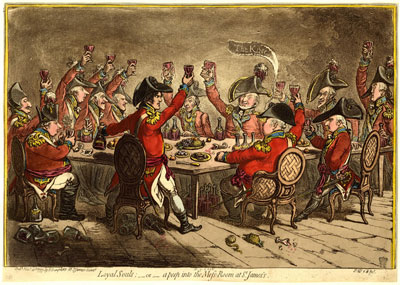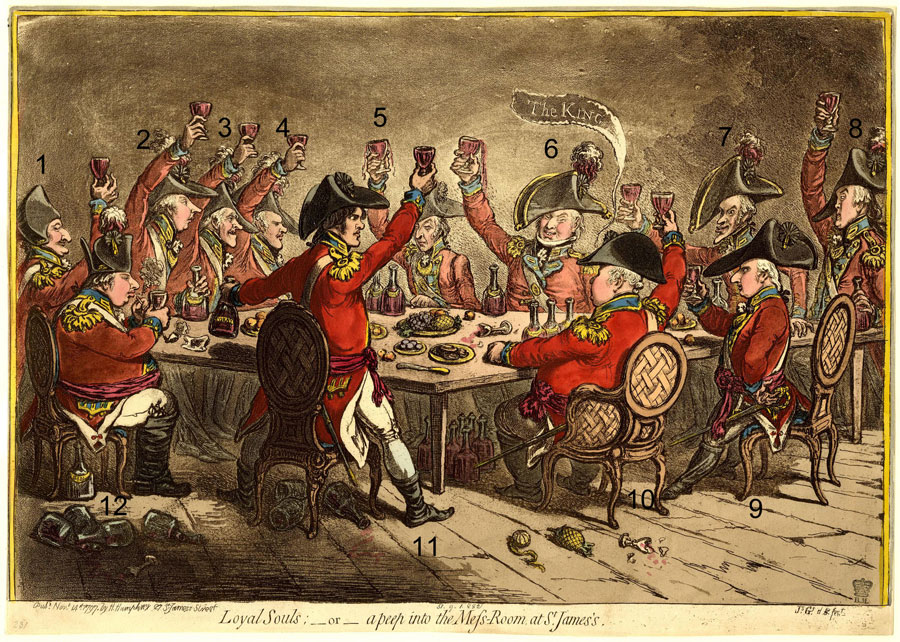Loyal Souls, or a Peep into the Mess Room at St James's
This is one of a number of prints featuring military personnel produced by Gillray in 1797. Others include:
- St George's Volunteers Charging Down Bond Street (March 1)
- Hero's Recruiting at Kelsey's (June 9)
- The Salute (July 10)
- Patern-Staff. Weymouth, 1797 (November 3)
- Brigade-Major. Weymouth, 1797 (November 15)
- A Dash up St James's Street. (December 6)
Loyal Souls purports to show the mess hall at St. James where members of the Life Guards and Foot Guards are drinking toasts to the King whom they are sworn to protect. And judging from the number of bottles on (and below) the table, their pledges are perhaps too frequently and too enthusiastically given.

[November 14, 1797]
© Trustees of the British Museum
Although it's clear from the distinctiveness of the faces around the table that these are caricature portraits of real soldiers, identifying them has been a challenge. Thomas Wright and R.H. Evans mention General Davies, the Duke of York, Colonel Jekykll, and a Captain Burch (sic) as among the twelve men represented in the print, but do not specify which ones are which. The British Museum commentary by Dorothy George adds three more to the list—William, Duke of Gloucester, Abel Rous Dottin, and a Captain Birch (sic). It also attempts to match names with the faces in the print. But there are clearly errors in the commentary. The identification of Abel Rous Dottin as the guard proposing the toast, for instance is almost certainly wrong. And, most egregiously, the commentary opens with the assertion (sadly repeated by almost every other museum and gallery containing the print):"Fifteen officers sit round a roughly made table on which are decanters and fruit." In fact, there are only twelve.
Thanks to Donald Coverdale, however, I was alerted to another copy of Loyal Souls recently sold on eBay that numbers and identifies ALL the men at the table in an unknown but presumably contemporary hand. I do not agree with all of its identifications. But, at minimum, this "annotated version" can serve as an opening for further discussion. So using its numbering (repeated more legibly below), I will attempt to describe the current state of the identification of the men in the mess hall.

[November 14, 1797]
© Trustees of the British Museum
Number 1
The annotated version of the print identifies the figure at the far left as "Gen'l Morrison." And indeed in A List of the Officers of the Army and Marines, published in 1797, a George Morrison appears as a Colonel (General in the Army) (p. 108). But having been born in 1703, Morrison would have been 94 when the print was published, which is clearly not what we see here. The British Museum is almost certainly correct in identifying him not as Morrison, but as General Thomas Davies. A few months earlier in July, Gillray had portrayed Davies reviewing his troops in The Salute, and the resemblance is unmistakable. As we will see, this is not the only portrait borrowed from Gillray's recent spate of prints concerning the military.
Number 2
The annotated version of the print identifies the next officer as Captain Shibberf(?). In this instance, I cannot find any such officer in A List of the Officers of the Army and Marines. So once again, the British Museum suggestion—that he is Prince William of Gloucester— is more likely to be correct. Gillray had portrayed "Slice" (as he was called by the other Royals) eight days earlier in Patern-Staff. Weymouth, 1797 so the Prince was defnitely on Gillray's mind. But the print of William that is most like the figure we see here is A Slice of Glo'ster Cheese (1795).
Number 3
The annotated version of the print identifies the third officer from the left as Gen'l Pennington of the Foot Guards. In A List of the Officers of the Army and Marines, a Lowther Pennington, a Colonel (Major General in the Army) appears as part of the recently disbanded 131st Regiment of Foot Guards (p. 331). But before being assigned to the 131st Regiment, he had for thirty years been a member of the Coldstream Guards, responsible for protecting the Monarchy. He would have been 52 years old in 1797, which is perhaps not inconsistent with the portrait we see here. The British Museum does not supply a name for this officer.
Number 4
The annotated version of the print identifies the fourth officer from the left as Sir [Illegible] Gordon of the Foot Guards. There are over 30 Gordons mentioned in A List of the Officers of the Army and Marines. (p. 436), but only two that could justify "Sir" preceding their names: the Honourable William Gordon (p.3) and John Gordon, Baronet. The Honourable William Gordon was promoted to Lieutenant General of the 71st (Highland) Regiment of Foot Guards in 1793 and General of the same Regiment on January 1st, 1798. John Gordon Bt. was made an Ensign in the "Coldstream Regiment of Foot Guards in April of 1795. There is a portrait of Sir William Gordon by Pompeo Batoni, but it looks nothing like the officer in the print. I have been unable to find a portrait of the Honourable John Gordon, so I can't rule out John as the mystery officer.
Number 5
The annotated version of the print identifies the heavy-lidded and tipsy officer near the center of the print as Lieutenant Lisham (?). But I have been unable to find any such name in A List of the Officers of the Army and Marines. What I believe to be same officer, however, can be seen (similarly half asleep) as the last soldier parading in Gillray's The Salute.
Number 6
The annotated version of the print identifies the sixth officer from the left as Captain Dottin of the 2nd Life Guards. And indeed A List of the Officers of the Army and Marines shows that there was a Captain Abel Rous Dottin as Captain in the Second Regiment of Life Guards (p. 50). The British Museum, however, identifies him without any other supporting evidence as the Duke of York. But, alas, I see no resemblance between the sixth officer and any other confirmed portrait of the Duke. So I'm inclined to assume, barring other evidence, that this is more likely to be Dottin than York. But if my theory for Number 11 (below) is allowed as a possibility, it is likely that neither of these identifications is correct.
Number 7
The annotated version of the print identifies the seventh officer as Capn Birch of the 1st Life Guards. A List of the Officers of the Army and Marines contains five Birchs: two Johns, a James, a Thomas, and a Robert Henry. The one who was part of the "First Regiment of Life Guards," however, is listed as Lieutenant James Birch. Another source, however, British Cavalry Regiments and the Men Who Led Them 1793-1815 lists him as Thomas James Birch and indicates that he became a Captain on August 15, 1798. If that is accurate, the fact that the annotated version lists him as Captain suggests that it was done some time after August 1798. But no matter what his given name or rank or whether his surname is spelled Burch or Birch, it is perfectly clear that he is the same officer who appears spooning himself a treat in Gillray's Hero's Recruiting at Kelsey's.
Number 8
The annotated version of the officer on the far right of the print identifies this soldier as Capn Churchill of the Foot Guards. A List of the Officers of the Army and Marines contains a William Churchill as a Lieutenant and Captain in the First Regiment of Foot Guards. (p. 94) But I have found no other information about him that could confirm or deny the attribution. The British Museum, following Wright and Evans, however, suggests that Number 8 might be a relation of the Jekyl[l] family. But the only Jekyll in the military that I have found is Captain Nathaniel Jekyll in the "43rd (or the Monouthshire) Reg't of Foot" who would be unlikely to appear in the mess at St. James.
Number 9
The annotated version of the print identifies this officer as Lt. O'Brien of the Foot Guards. A List of the Officers of the Army and Marines contains a William O'Brien as a "Captain Lieut and Captain in the Twelfth (or the East Suffolk) Regt of Foot." (p. 124). But I have found no further informatioon about him. The British Museum does not offer an identification.
Number 10
The annotated version of the print identifies this officer as Gen'l Burrard of the Foot Guards. A List of the Officers of the Army and Marines confirms that there was a Colonel Harry Burrard in the First Regiment of Foot Guards (p. 93) and an "Aide de Camp to the King." (p. 11) The British Museum, on the other hand, identifies the stout officer as Captain Abel Rous Dottin. In this case, I believe the British Museum is wrong. The stout officer is most likely the same Harry Burrard who appears in Gillray's Brigade-Major. Weymouth, 1797.
Number 11
The annotated version of the print identifies this officer as Capn Storey of the Foot Guards, A List of the Officers of the Army and Marines contains a George Storey as Lieutenant and Captain in the "Third Regiment of Foot Guards." But there is also a Captain John Storey who was part of the "Fourth (or the King's own) Regt. of Foot." (p. 108) Without further information, it is impossible to declare that either of these identifications is correct. But I have one more, admittedly speculative, identification: Abel Rous Dottin had a brother, Samuel Rous Dottin also in the military. Figures 11 and 4 have a distinct family resemblance in their slightly snub nose and the curl of their lips. Could these be two brothers?
Number 12
The annotated version of the print identifies the fat officer with a pipe as Capn Waldon or Walton of the Life Guards. A List of the Officers of the Army and Marines does indeed record a Captain Charles M.B. Walton in the "First Regiment Life Guards." (p. 49) But, as usual, I have no further information about Walton that could confirm or deny the identification. The British museum provides no guess at all. But, to my way of thinking, the clay pipe in his hand and the bottle of [Holland] Gin beneath his chair both suggest a Dutch connection. And his profile has a distinctly Hanoverian look to it. So I'm inclined to differ from the annotation scribe and suggest that Number 12 is most likely the Duke of York whom Gillray satirized for his premature celebrations of some early British victories in Holland in Fatigues of the Campaign in Flanders.
Sources and Reading
- Commentary from the British Museum on Loyal Souls, or a Peep into the Mess Room at St James's.
- "Coldstream Guards," Wikipedia
- "Foot guards," Wikipedia
- "Life Guards (United Kingdom)," Wikipedia
- A List of the Officers of the Army and Marines
- Tracy Chevallier, "Lieutenant-Colonel Thomas James Birch (c.1768-1829) Historical Figures"
- "Sir Harry Burrard," Wikipedia
- "Thomas Davies (British Army officer)," Wikipedia
- "Abel Rous Dottin," Wikipedia
- "Samuel Rous Dottin," Legacies of British Slavery
- "Prince William Frederick, Duke of Gloucester and Edinburgh" Wikipedia
- "William Gordon (British Army officer)," Wikipedia
- "Lowther_Pennington,_2nd_Baron_Muncaster," Wikipedia
- Thomas Wright and R.H. Evans, Historical and Descriptive Account of the Caricatures of James Gillray #445.
- Thomas Wright and Joseph Grego, The Works of James Gillray, the Caricaturist; With the History of His Life and Times, p. 231.
Comments & Corrections
NOTE: Comments and/or corrections are always appreciated. To make that easier, I have included a form below that you can use. I promise never to share any of the info provided without your express permission.